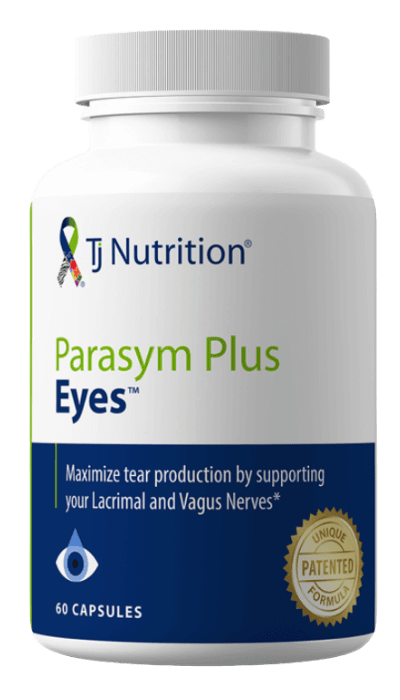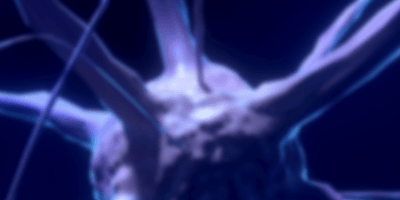Have you tried everything to keep your eyes moist? Eye drops, eye ointments, and even punctal plugs boost moisture or try to retain moisture, but they do not address the underlying causes of low tear production. Therefore, these products are limited in what they can do for you. When tear production is not optimal and dry eyes result, these products do nothing to support the systemic (body-wide) process resulting in less-than-optimal tear production.
How Is Tear Production A Systemic Process? First, Let’s Look At How Tears Are Formed.
Your lacrimal gland produces the bulk of your tears. The lacrimal nerve signals the lacrimal gland to produce tears whenever you need them. This is part of your Parasympathetic Nervous System (the same system of the body that allows you to rest, to calm yourself, and to digest food). The lacrimal nerve communicates with the lacrimal gland via a chemical messenger called acetylcholine.
The lacrimal nerve receives the signal that you need more tears. It then releases acetylcholine (the chemical messenger) which immediately instructs the lacrimal gland to pump out tears, resulting in increased moisture!
When acetylcholine levels are low for any reason, or if the lacrimal nerve isn’t releasing acetylcholine sufficiently, tear production goes down and dry eyes result.
⇨ Keeping your eyes moist is one of the primary functions of your Parasympathetic Nervous System.

So Why Does Your Parasympathetic Nervous System Need Support?
The release of acetylcholine declines with age and inflammation. And sometimes our diet and our genes make it harder for us to produce enough acetylcholine. When this happens, the parasympathetic nervous system is less efficient, and tear production declines.
What Else Does The Parasympathetic Nervous System Support?
The Parasympathetic Nervous System supports relaxation. It calms the body, allows a slower heart rate, slows down rapid breathing, and allows us to recover from stress.
The Parasympathetic Nervous System also supports the vagus nerve. Your vagus nerve is responsible for every aspect of proper digestion, from swallowing and motility (movement of food and stool throughout your digestive tract) to normal stomach acid production, gallbladder function, and pancreatic function. These organs are critical for optimal digestion of nutrients.
Importantly, your vagus nerve is also the anti-inflammatory pathway of the body. Although some inflammation is good (and even necessary for recovery from illness or injury), chronic inflammation can be problematic — the parasympathetic nervous system (via the vagus nerve) helps retain the proper balance of inflammation. Proper ocular moisture depends upon both normalized tear production AND balanced, normal levels of inflammation.
How Does Inflammation Affect Tear Production?
Inflammation (of the eyes or the body in general) can limit the release of acetylcholine, thus resulting in less than optimal tear production. By supporting the parasympathetic nervous system, tear production is maintained in two ways:
- Direct support of the lacrimal nerve to allow normal tear production.
- Indirect support by balancing the inflammation that limits tear production (via support of the vagus nerve).
If both of these can be addressed simultaneously, the combination is incredibly powerful!
To prevent dry eyes, normalize tear production, and balance inflammation, you must support the parasympathetic nervous system — including the vagus nerve and the lacrimal nerve.
If you’d like to increase your tear production naturally, you can’t ignore the role of the parasympathetic nervous system!
Dr. Diana Driscoll, an eye doctor, has received two patents to date concerning acetylcholine, the vagus nerve, and a unique treatment for dry eyes based on supporting the parasympathetic nervous system. Truly a new discovery, this breakthrough is helping people today.
REFERENCES:
Hodges, R. R., & Dartt, D. A. (2003). Regulatory pathways in lacrimal gland epithelium. International review of cytology, 231, 129-196. [Full Article]
Dartt, D. A. (2009). Neural regulation of lacrimal gland secretory processes: relevance in dry eye diseases. Progress in retinal and eye research, 28(3), 155-177. [Full Article]
Kossler, A. L., Wang, J., Feuer, W., & Tse, D. T. (2015). Neurostimulation of the lacrimal nerve for enhanced tear production. Ophthalmic plastic and reconstructive surgery, 31(2), 145. [Full Article]
Arenson, M. S., & Wilson, H. (1971). The parasympathetic secretory nerves of the lacrimal gland of the cat. The Journal of Physiology, 217(1), 201-212. [Full Article]
Zoukhri, D. (2006). Effect of inflammation on lacrimal gland function. Experimental eye research, 82(5), 885-898. [Full Article]
Pramanik, T., & Ghising, R. (2009). Salivation induced better lacrimal gland function in dry eyes. Nepal Med Coll J, 11(4), 258-260. [Full Article]






